Motorola Mobility T56LC1 Portable Cellular/ PCS/ AWS CDMA Transceiver with Bluetooth User Manual Exhibit 8 Users Manual
Motorola Mobility LLC Portable Cellular/ PCS/ AWS CDMA Transceiver with Bluetooth Exhibit 8 Users Manual
Exhibit 8 Users Manual

APPLICANT MOTOROLA INC. FCC ID: IHDT56LC1
INSTRUCTION MANUAL
A representative version of the user's manual follows:
Exhibit 8
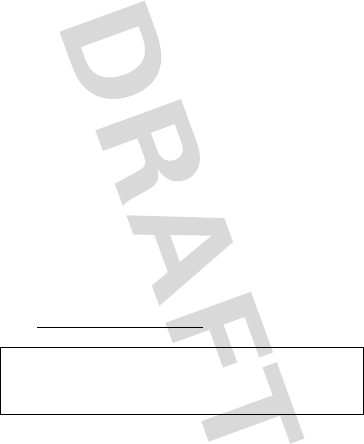
1
congratulations!
Congratulations on your new MOTO
TM
WX404 CDMA
wireless phone! Its rugged, sporty design fits your
energetic lifestyle.
Take pictures and video in a snap with the 1.3 megapixel
camera with 4x digital zoom. Listen to your favorite
music with the digital music player, and watch your
music come to life with stunning visual effects.
We’ve crammed all of the main features of your phone
into this handy guide, and in a matter of minutes we’ll
show you just how easy your phone is to use. So go on,
check it out, and put your phone to work.
more information
To learn even more about your phone and accessories,
go to
www.motorola.com/support
.
Caution:
Before using your phone for the first time,
please read the important
Safety, Regulatory & Legal
information at the back of this guide (page 49).
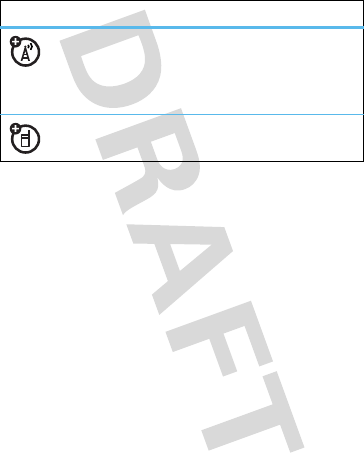
2
this guide
symbols in this guide
This means a feature is network, SIM card, or
subscription dependent and may not be
available in all areas. Contact your service
provider for more information.
This means a feature requires an optional
accessory.

3
contents
your phone . . . . . . . . . . . . . . . . . . . . . . . . . . . . . . . . . 4
main menu . . . . . . . . . . . . . . . . . . . . . . . . . . . . . . . . . 5
settings menu . . . . . . . . . . . . . . . . . . . . . . . . . . . . . . . 6
let’s go . . . . . . . . . . . . . . . . . . . . . . . . . . . . . . . . . . . . . 7
basics. . . . . . . . . . . . . . . . . . . . . . . . . . . . . . . . . . . . . . 8
home screen . . . . . . . . . . . . . . . . . . . . . . . . . . . . . . . . 11
calls . . . . . . . . . . . . . . . . . . . . . . . . . . . . . . . . . . . . . . 12
phonebook . . . . . . . . . . . . . . . . . . . . . . . . . . . . . . . . 15
messages . . . . . . . . . . . . . . . . . . . . . . . . . . . . . . . . . . 17
text entry. . . . . . . . . . . . . . . . . . . . . . . . . . . . . . . . . . 20
tips & tricks. . . . . . . . . . . . . . . . . . . . . . . . . . . . . . . . 22
personalize . . . . . . . . . . . . . . . . . . . . . . . . . . . . . . . . 24
music . . . . . . . . . . . . . . . . . . . . . . . . . . . . . . . . . . . . . 27
photos . . . . . . . . . . . . . . . . . . . . . . . . . . . . . . . . . . . . 34
Bluetooth® wireless. . . . . . . . . . . . . . . . . . . . . . . . . 36
cable connections. . . . . . . . . . . . . . . . . . . . . . . . . . . 39
memory card. . . . . . . . . . . . . . . . . . . . . . . . . . . . . . . 42
tools. . . . . . . . . . . . . . . . . . . . . . . . . . . . . . . . . . . . . . 44
security . . . . . . . . . . . . . . . . . . . . . . . . . . . . . . . . . . . 46
service & repairs. . . . . . . . . . . . . . . . . . . . . . . . . . . . 48
Safety, Regulatory & Legal . . . . . . . . . . . . . . . . . . . 49
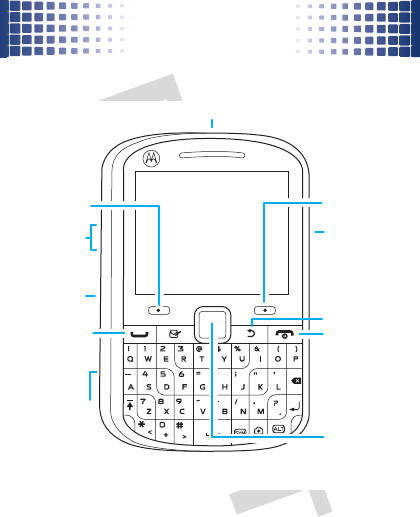
your phone
4
your phon e
the important keys & connectors
Power/
End Key
Turn on/off,
hang up,
exit menus.
Center Key
Open menu
& select.
Right Soft
Key
Voice Key
Clear/
Back Key
Volume
Keys
Send Key
Make &
answer
calls.
Left Soft
Key
Smart Key
Micro USB
Connector
Charge &
connect to
PC.
2.5 mm Headset Jack
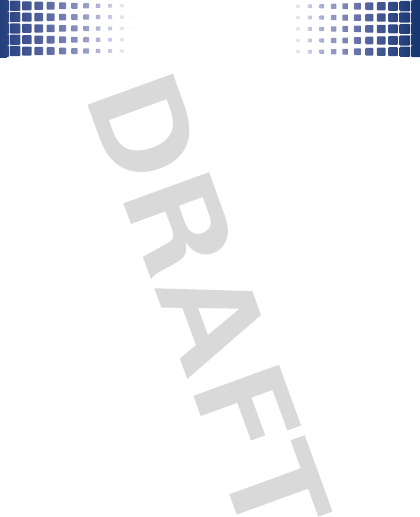
main menu
5
mai n menu
L
Phonebook
•New
• Contact List
• Groups
• Speed Dial
j
Multimedia
• Music & Sounds
•Camera
• Pictures
•StorageDevice
u
Settings
• (see next page)
m
Tools
• Voice Commands
• Datebook
•AlarmClock
•WorldClock
•Calculators
• Notepad
• Stopwatch
ô
Browser
g
Messaging
• Create Message
• Conversations
•Voicemail
•Email*
•IM*
•Drafts
—
Music Player
Û
Phone Info
• My Number
•SW/HWVersion
• Icon Glossary
G
Datebook
q
Recent Calls
• Received Calls
• Missed Calls
• Dialed Calls
• All Calls
•Timers
J
Brew
à
Ringtones
This is the standard main menu layout.
Your phone’s menu may be different.
* Optional and/or network dependent
feature. Not available in all areas.
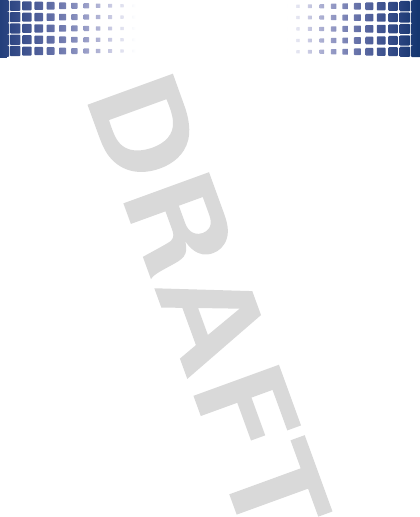
settings menu
6
setting s menu
• Sounds
• Easy Setup
• Call Ringtone
• Message Ringtone
• Voicemail Ringtone
• Ring and Vibrate
• Alert Reminders
• Service Alerts
•PowerOn/Off
• Voice Readout
• Keypad Volume
• Volume Sidekeys
•Display
• Easy Setup
• Banner
• Backlight
• Brightness
• Wallpaper
•Skins
•ClockFormat
• Menu Font Size
• Idle Shortcuts
• Phone
• Airplane Mode
• Keypad Lock Settings
• Language
• Location
• Security
• Network Selection
• ActiveLine*
•TextLearning
• Quick Contact Search
• Contact List Search
•Call
• Answer Options
• Auto Retry
• TTY Setup
• One Touch Dial
• Int’l Dialing
• DTMF Tones
• Hearing Aid
• Predefined Response
• Bluetooth
•AddNewDevice
•USB
•MassStorage
• Modem/COM
• Storage Device
• Save Options *
• Phone Memory
•MemoryCard*
• Phone Info
• My Number
•SW/HWVersion
• Icon Glossary
•SetupWizard
* Optional and/or network dependent
feature. Not available in all areas.
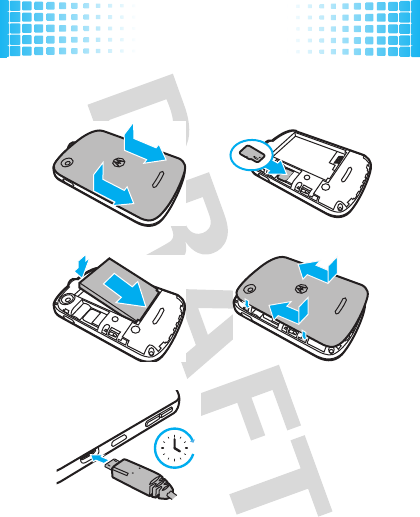
let’s go
7
let’s go
let’s get you up & running
Caution:
See
Battery Use & Safety
(page 49).
1
cover off:
2
microSD:
3
battery:
4
cover on:
5
charge:
4H
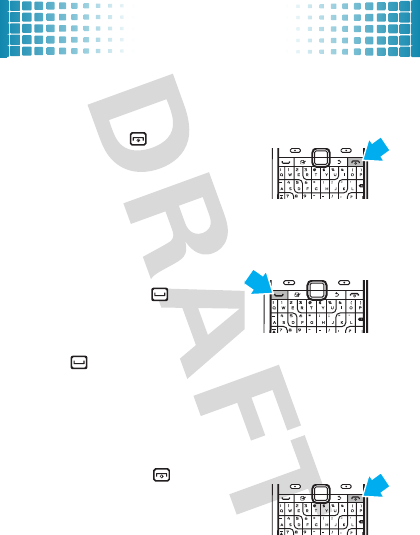
basics
8
basic s
here’s a few essentials
turn it on & off
Press and hold for a few
seconds or until the screen lights
up.
make & answer
calls
To
make a call
, enter a phone
number and press .
To
answer a call
when your
phone rings and/or vibrates, just
press .
During a call, you can press
Mute
,
Spkr On
, or press
Options
to
select other in-call options (page 13).
end a call
To
hang up
, press .
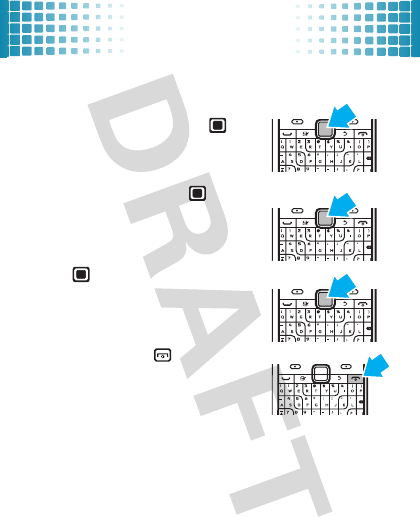
basics
9
menu navigation
Press
Menu
to open the main menu
(this may be the center key or
a soft key, depending on your
phone).
Scroll the navigation key up,
down, left, or right to scroll to a
menu option.
Press to select the highlighted
option.
If necessary, press to return to
the home screen.
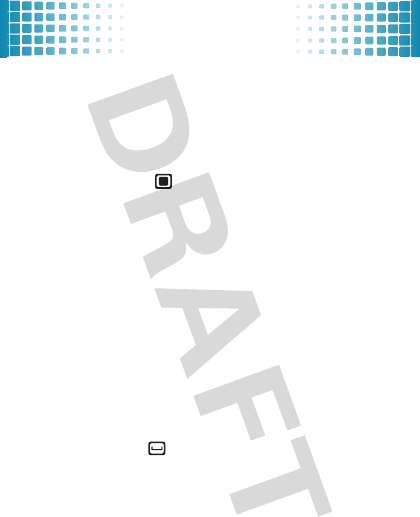
basics
10
store contacts
1
Enter a phone number in the home screen.
2
Press
Save
.
3
Set the number type (
Mobile 1
,
Mobile 2
,
Home
,
Work
, or
Fax
), and press .
4
Enter contact details, and press
Save
. (To enter text,
see page 20.)
call or text contacts
Find it:
Menu
>
LPhonebook
>
Contact List
1
Scroll to the contact.
Shortcut:
To jump to a contact, enter the first few
letters of the name.
If a contact has more than one number, scroll left or
right to choose a number.
2
To
call
, press .
To
send a text message
, press
Send Msg
.
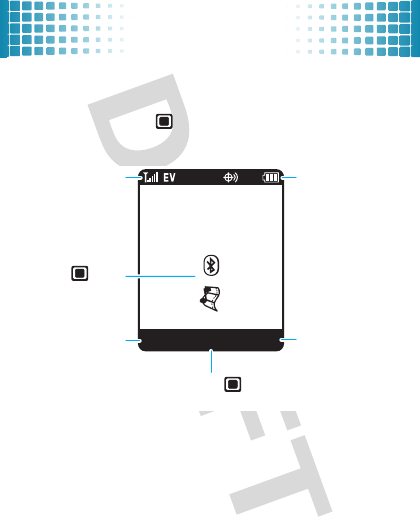
home screen
11
home screen
quick access to the information you need most
The home screen appears when you turn on the phone,
or when you press . Phone status indicators appear
at the top of the home screen:
Note:
Your phone’s home screen may be a little different.
Tip:
For a description of the status indicators that can
appear on your phone, press
Menu
>
ÛPhone Info
>
Icon Glossary
>
Status Bar
.
Wed 10/15/10
12:15 pm
Message ContactsMenu
Left Soft Key
Signal Strength
Scroll
up or
down to open
shortcuts.
Center Key
Right Soft Key
Battery Level
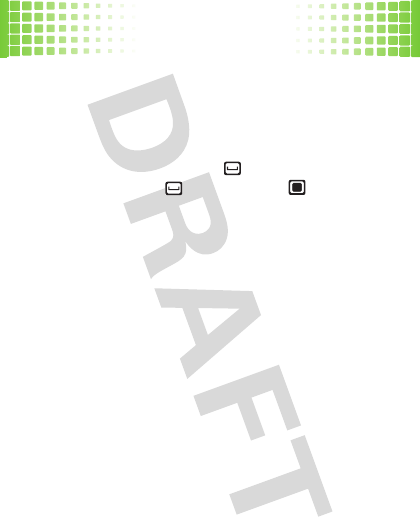
calls
12
calls
it’s good to talk
For the basics, see page 8.
redial a number
From the home screen, press to see
All Calls
. Scroll to
a number, and press to call it. Press to view call
details.
go handsfree
To
activate the speakerphone
during a call, press and
hold the speaker key (page 4) on the side of your phone.
The phone plays an audible alert, and shows
q
and
Speaker Phone On
.
To
turn off the speakerphone
, press the speaker key
again. Your phone shows
Speaker Phone Off
.
Note:
You can also use
headsets or car kits
with a
2.5 mm wired connection (page 4) or Bluetooth®
wireless connection (page 36). The speakerphone won’t
work when your phone is connected to a handsfree
headset or car kit.
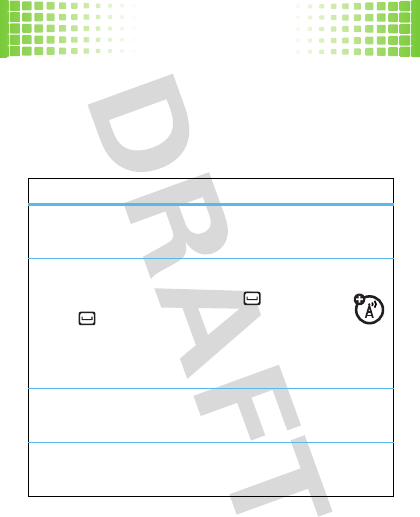
calls
13
Note:
Using a mobile device or accessory while driving
may cause distraction and may be illegal. Always obey
the laws and drive safely.
in-call options
features
mute a call
Press
Mute
start a 3-way call
Dial the next number and press , then
press again.
To dial a
contact
, press
Options
>
Contacts
.
To dial a
recent call
, press
Options
>
Recent Calls
.
connect/disconnect a Bluetooth® headset
Press
uSettings
>
Bluetooth
.
read or send a message
Press
Menu
>
gMessaging
.
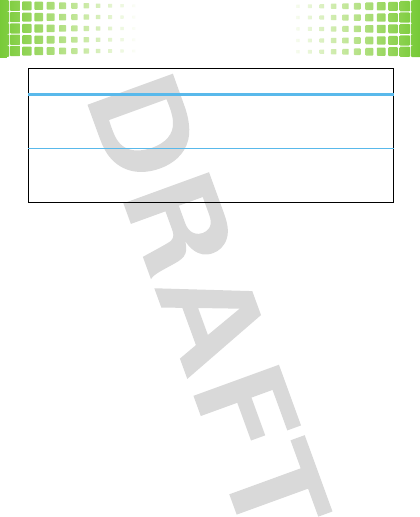
calls
14
emergency calls
Note:
Your service provider programs one or more
emergency phone numbers (such as 911 or 112) that you
can call under any circumstances, even when your phone
is locked. Emergency numbers vary by country. Your
pre-programmed emergency number(s) may not work in
all locations, and sometimes an emergency call cannot
be placed due to network, environmental, or interference
issues.
To call an emergency number, enter the emergency
number and press
¯
.
Note:
Your mobile device can use GPS or AGPS
technology to help emergency services find you
(page 53).
see your phone number
Press
Menu
>
uSettings
>
Phone Info
>
My Number
.
read or make an appointment
Press
Menu
>
GDatebook
.
features
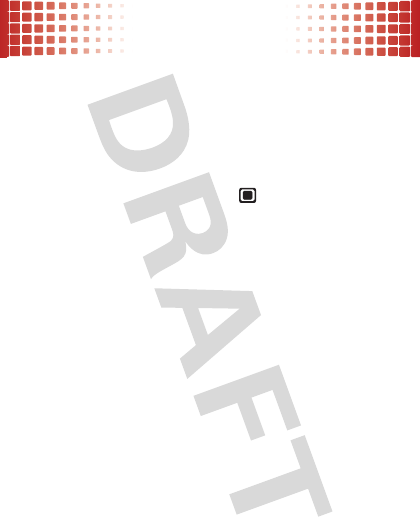
phonebook
15
phonebook
got their number? now do more
To store and call contacts, see page 10.
edit or delete contacts
Find it:
Menu
>
LPhonebook
1
Scroll to
Contact List
and press .
2
Scroll to the contact or enter the first letters of a
contact you want.
To
edit
the contact, press
Options
>
Edit Contact
. You can
edit existing information, and store additional
information for the contact, including multiple phone
numbers, email addresses, personal information, a
picture ID, and ringer IDs. To save your changes,
press
Save
.
To
delete
the contact, press
Options
>
Delete
.
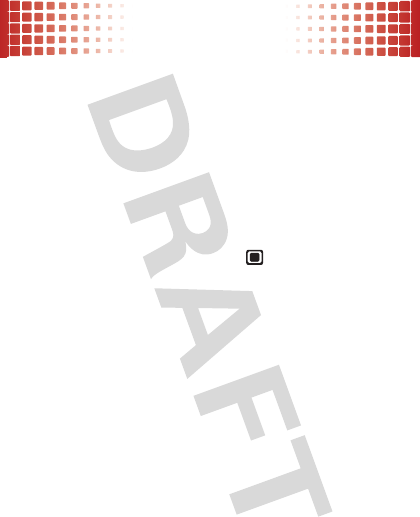
phonebook
16
speed dial contacts
Note:
Speed dial number 1 is already assigned to your
voicemail number.
To
assign
a speed dial number to a contact:
Find it:
Menu
>
LPhonebook
>
Speed Dial
1
Scroll to an unassigned speed dial number and
press
Set
.
2
Scroll to a contact and press .
3
Select
Yes
to confirm your selection.
As you scroll through contacts, speed dial numbers are
identified by the speed dial indicator
>
.
To
activate
speed dialing, press
Menu
>
uSettings
>
Call
>
One Touch Dial
>
On
.
To
call speed dial number 1 through 9:
Press and hold
the single-digit speed dial number for one second.
To
call a double-digit speed dial number:
When you
enter the speed dial number, press and hold the second
digit. (For example, to call speed dial number 23,
press
2
, then press and hold
3
).
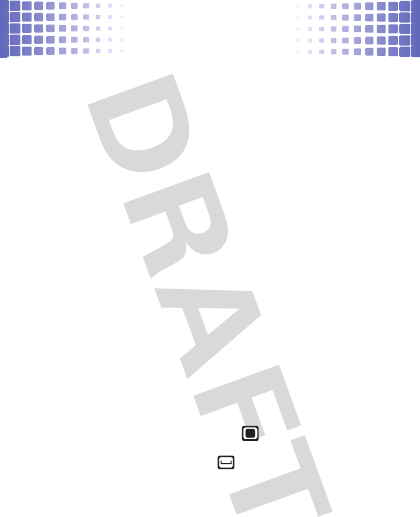
messages
17
messages
sometimes it’s better 2 say it in a message
create & send text messages
Find it:
Menu
>
gMessaging
>
Create Message
1
Enter contact names, or press
Add
to choose
recipients.
2
Scroll down to the text entry area and enter text
(page 20).
While entering text, you can press
Options
for
message options.
3
To send the message, press
Send
.
receive text messages
Find it:
Menu
>
gMessaging
>
Conversations
1
Scroll to a message. (Newest ones are listed first.)
2
To read the message, press .
To call the sender, press .
To open message options (such as
Forward
or
Lock
),
press
Options
.
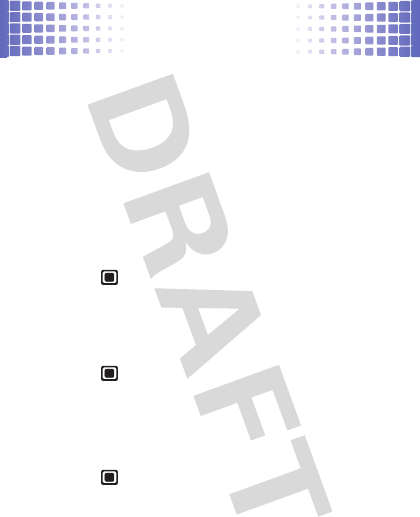
messages
18
conversations
Conversations
organize your sent and received messages by
topic, so you can easily follow each conversation.
Find it:
Menu
>
gMessaging
>
Conversations
1
Scroll to the message sender you want.
When a message sender is highlighted, you see the
date, time, and subject of the last message you
received from the sender.
2
Press to select the highlighted sender.
You see a partial view of the last message you
received from the sender. Above that is a partial
view of the previous message.
3
Press to open and view a highlighted message.
Scroll up to view earlier messages.
Scroll down to the entry area at the bottom of the
screen to enter a reply. Press
Send
to send the reply.
4
Press to return to the home screen.
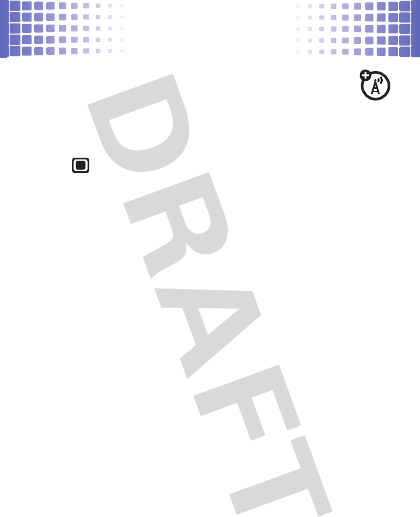
messages
19
voicemail
When you
receive
a voicemail message, your
phone shows
y
and
New Voicemail
. To hear the new
message, select
Listen Now
. To close the notification,
press .
To
check
your voicemail from the home screen, press
and hold
1
.
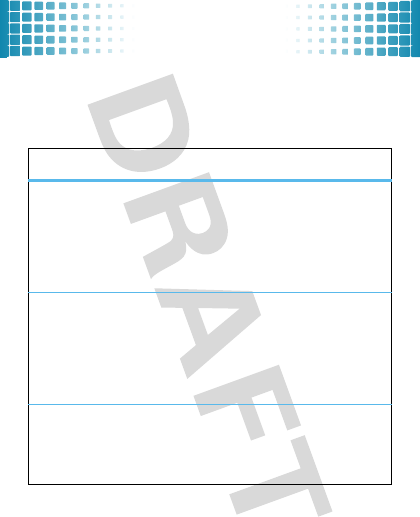
text entry
20
text entry
how fast can u text?
To
change modes
when you are entering text, press
Menu
>
gMessaging
>
Options
>
Entry Mode
:
entry modes
iTAP English
/
iTAP Spanish
The phone predicts the word you want,
with just one keypress per letter. Press
*
to change between capitalization
options (no capitals, first letter in a
sentence capitalized, all capitals).
Abc
/
ABC
Press a key repeatedly to cycle through
its letters and number.
Abc
—
capitalize
the first letter in the sentence.
ABC
—
enter all uppercase letters (not
available when editing a contact).
123
Enter numbers only.
Shortcut:
In other modes, press and
hold a number key to enter its number.
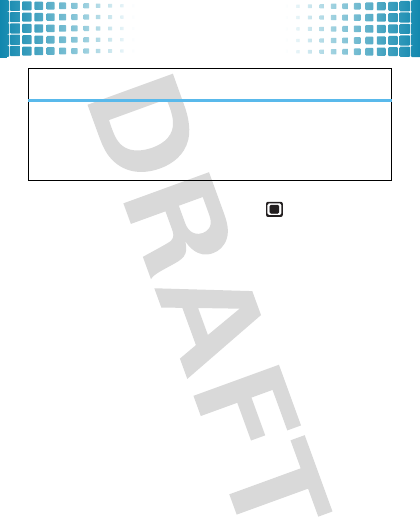
text entry
21
To
accept
a word completion, press right.
To
enter a space
, press
#
.
To
delete a character
, press
|
(to delete a whole
word, press and hold
|
).
Symbols
Enter symbols.
Shortcut:
In other modes, press
1
to
enter basic symbols or punctuation.
entry modes
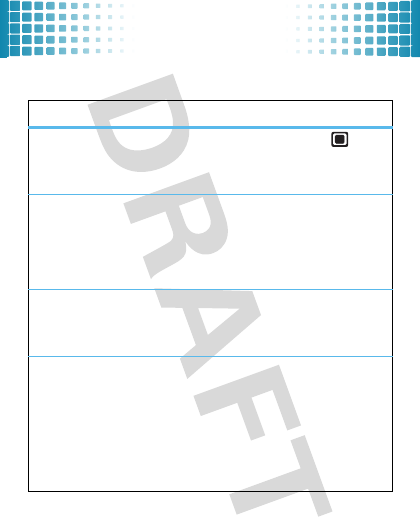
tips & tricks
22
tips & tricks
a few ways to make your phone even easier to use
To...
use home
screen
shortcuts
In the home screen, press up
or down. )
lock/unlock
keypad
To
lock
the keypad, press and
hold
*
.
To
unlock
the keypad, press
Unlock
>
Yes
.
turn the
speakerphone
on/off
Press and hold the speaker key on
the side of your phone (page 4).
create a
voice record
Press and hold the voice key on the
side of your phone (page 4).
To
listen
to the voice record,
press
Menu
>
jMultimedia
>
Music & Sounds
>
Ringtones & Sounds
>voice record.
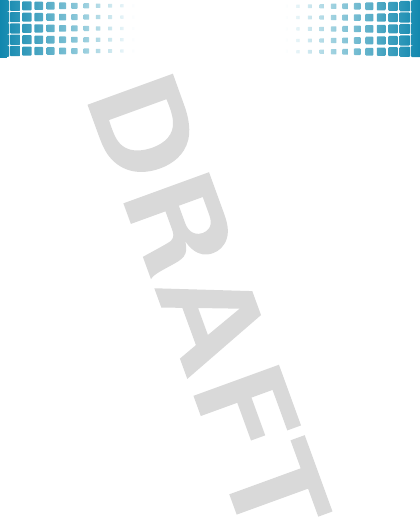
tips & tricks
23
improve battery life
•
To make your
backlight
turn off sooner: From the
home screen, press
Menu
>
uSettings
>
Display
>
Backlight
, select
Display
or
Keypad
, and select
5seconds
.
•
To turn off
Bluetooth® power
when you’re not using
it: From the home screen, press
Menu
>
CBluetooth
,
and press
Turn Off
.
voice commands
Press and release the voice key on the side of your
phone (page 4), then speak a voice command:
• Call <Name or #>
• Send Message <Name or #>
• Go To <Shortcut>
•Check <Item>
• Contact <Name>
•Redial
• Play <Playlist>
•Help
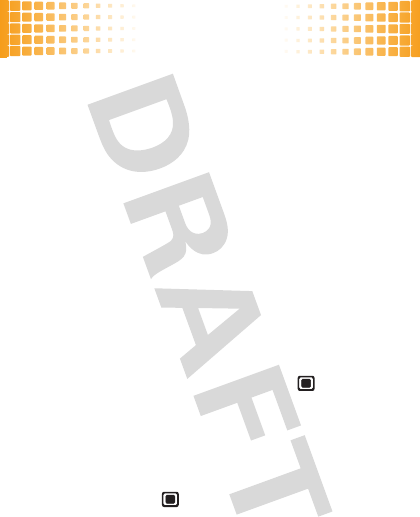
personalize
24
persona liz e
add your personal touch
ringtones
You can select ringtones for incoming calls and other
events (such as new messages), and set the master
volume for all ringtones.
easy setup
To quickly change your phone’s basic ring and volume
settings, press
Menu
>
uSettings
>
Sounds
>
Easy Setup
.
set call ringtones
Find it:
Menu
>
uSettings
>
Sounds
>
Call Ringtone
>
Home Calls
or
Roaming Calls
To set a
single ringtone
for home calls: Select
Single Tone
,
scroll to the ringtone you want and press .
Shortcut:
Press
Menu
>
àRingtones
, scroll to a ringtone,
press
Set As
>
Default Ringtone
.
To select
multiple ringtones
that will play randomly for
home calls: Select
Shuffle Multiple
, scroll to each ringtone
you want and press . When you’re finished,
press
Done
.
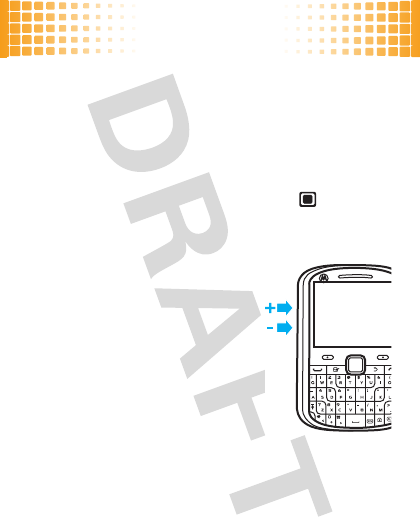
personalize
25
Note:
Shuffle Multiple
depletes your battery’s charge more
quickly than
Single Tone
.
set message ringtones
Find it:
Menu
>
uSettings
>
Sounds
>
Message Ringtone
or
Voicemail Ringtone
Scroll to the ringtone you want and press .
set master volume
Press the volume keys up or down
to set the ringtone master
volume
level, set the phone to
beep
or
vibrate
for incoming calls, set an
event
alarm
, or turn all sounds
off
.
Note:
Ringtones do not sound
when the master volume is set
to
Vibrate Only
,
Alarm Only
, or
All Sounds Off
.
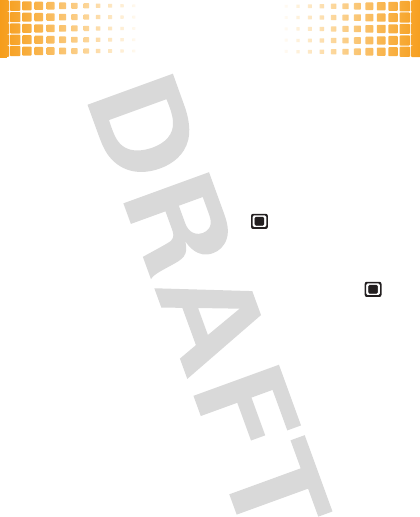
personalize
26
wallpaper
Set a photo, picture, or animation as a wallpaper
(background) image in your home screen.
Find it:
Menu
>
uSettings
>
Display
>
Wallpaper
>
Main Screen
or
Front Screen
To set a
single picture
as a wallpaper: Select
Single
, scroll
to the picture you want and press .
To select
multiple pictures
that will show randomly in
the home screen: Select
Shuffle Multiple
, scroll to each
downloaded or captured picture you want and press .
When you’re finished, press
Done
.
skins
Set the overall look and feel of your phone’s screen.
Find it:
Menu
>
uSettings
>
Display
>
Skins
> skin
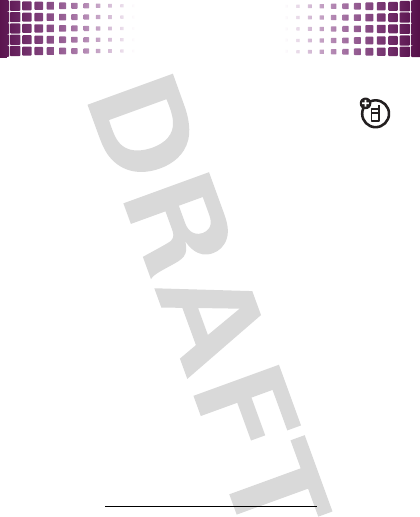
music
27
musi c
when music is what you need...
Note:
You’ll need to install an optional microSD
memory card in your phone to use the music
player.
Note:
Your phone supports Microsoft® Windows® XP
and Windows Vista®. Other operating systems may not
be compatible.
get music
Just load your favorite music onto your Windows® PC,
then transfer the music from the PC to your phone.
Note:
Your phone does not support DRM-protected song
files. Your phone’s music player can play the following
types of song files:
MP3
,
AAC
,
M4A
,
WMA
.
You can
buy
song files from on-line music stores (such
as Amazon, Rhapsody, and Napster).
You can also
rip a CD
(load song files from a music CD
onto your PC) with Microsoft Windows Media Player
version 11 or later. You can download Windows Media
Player from
www.microsoft.com/windowsmedia
.
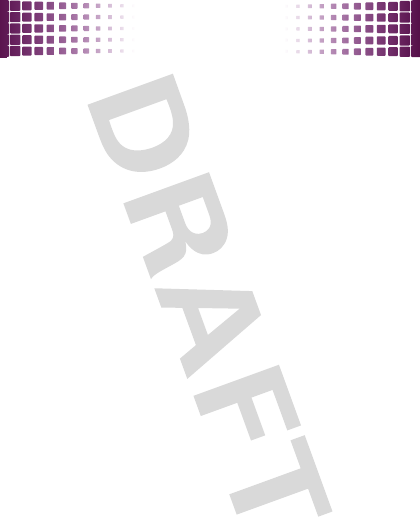
music
28
1
On your Windows PC
, open Windows Media
Player 11.
2
Insert a CD in your computer’s CD drive.
3
In the Windows Media Player window, click the
“Rip” tab.
4
Select the songs you want to import and click “Rip
Music“.
If your computer is connected to the Internet, the media
player may retrieve information such as song titles,
album name, artist name, and album artwork. This
information will appear in your phone’s music player
screen after you transfer the music to the phone.
Note:
The unauthorized copying of copyrighted materials
is contrary to the provisions of the Copyright Laws of the
United States and other countries. This device is
intended solely for copying non-copyrighted materials,
materials in which you own the copyright, or materials
which you are authorized or legally permitted to copy. If
you are uncertain about your right to copy any material,
please contact your legal advisor.
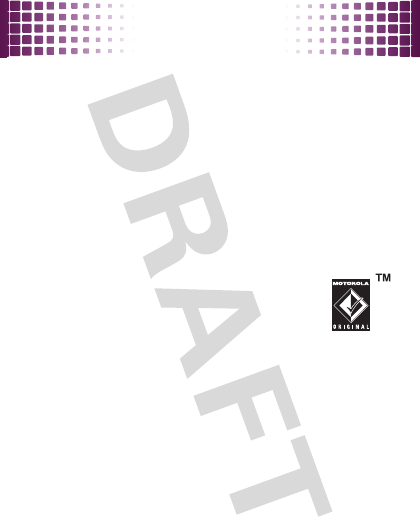
music
29
transfer music
Note:
Your phone’s music player can play the following
types of song files:
MP3
,
AAC
,
M4A
,
WMA
.
To
connect
your phone to your Windows PC:
1
Insert a microSD memory card into your phone
(page 7).
2
Set your phone to
Mass Storage
mode by pressing
Menu
>
uSettings
>
USB
>
Mass Storage
.
3
Connect a Motorola Original USB cable
to your phone (page 39) and your PC.
Note:
Some phone functions are
temporarily unavailable when a USB
connection is active.
Now that you’ve connected, use
USB drag and drop
to
copy your music:
1
On your Windows PC
, double-click on
“My Computer” to find the “Removable Disk” icons
for your phone and memory card.
2
Double-click the “Removable Disk” icon for the
memory card.
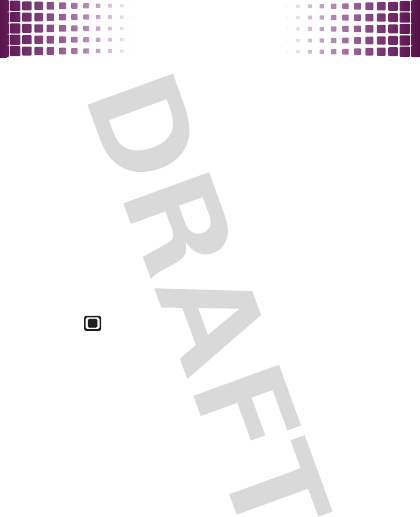
music
30
3
In the “Removable Disk” window, create the
“my_music” folder (if it doesn’t already exist).
4
Drag and drop song files onto the “my_music”
folder.
5
When you’re done, right-click the “Safely Remove
Hardware” icon in the system tray at the bottom of
your computer screen, then select “USB Mass
Storage Device” (your memory card).
6
Disconnect the USB cable.
play music
Find it:
>
—Music Player
> category > song or playlist
You can select a song or playlist from these categories:
All Songs
,
Playlists
,
Artists
,
Albums
, or
Genres
.
Note:
If you can’t find artist, album, or genre information
for a song, the information may not be available.
Shortcut:
In a song list, press a key to jump to songs
that begin with the letters on the key.
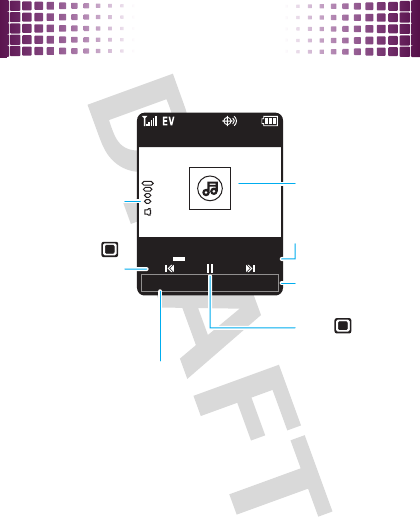
music
31
While a song is playing, use the following keys to control
song playback.
Note:
Your phone may look different.
To
hide
the music player while music plays, press
Settings
>
Background Play
.
To
return
to the music player from the home screen,
press
Menu
>
—Music Player
.
Settings List
Song Title
03:1500:30
Artist, Album
Select player
settings.
View song list.
Press
to
pause/play.
Song Length
Album Artwork
(if available)
Press
left/right to skip
songs. Press &
hold to rewind
or fast forward.
Press volume
keys to adust
volume level.
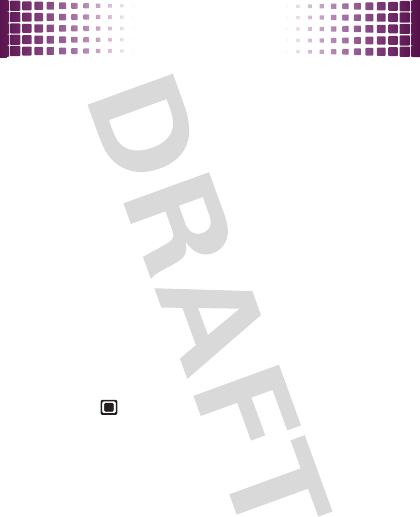
music
32
If you receive a call during a song
, the music player
pauses the song until the call is over.
playlists
Personalize your music collection by creating your own
playlists.
To
create
a playlist:
Find it:
Menu
>
—Music Player
>
Playlists
1
Press
Options
>
Create Playlist
.
2
Enter a name for the playlist and press
Done
.
Note:
The name cannot exceed 32 characters, and
cannot include the characters / \ : * ? < > | “
3
With the new playlist highlighted on the
Playlists
screen, press
Options
>
Add Songs
. Scroll to a song and
press .
Repeat this step to add more songs.
4
Press
Options
>
Add Marked to Playlist
to add the marked
songs to the playlist.
To
add a song
to a playlist: Scroll to the playlist and press
Options
>
Add a Song
.
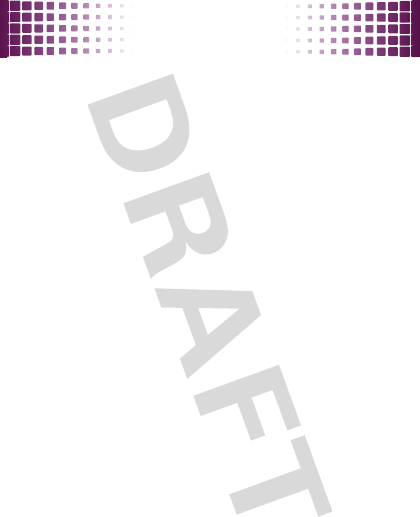
music
33
To
remove a song
from a playlist: Select the playlist,
scroll to the song and press
Options
>
Remove from Playlist
.
To
delete
a playlist: Scroll to the playlist and press
Options
>
Delete Playlist
.
wake up music player
While the music player is active, your phone may
conserve battery power by turning off the display and
keypad backlights.
To turn the display and backlights back on, press any key.
customize music player
Find it:
Menu
>
—Music Player
Press
Settings
, then select
Audio Effects
,
Visual Effects
,
Repeat
,
Shuffle
, or
Help
.
When a song is playing, you can also select
Add to Playlist
or
Background Play
.
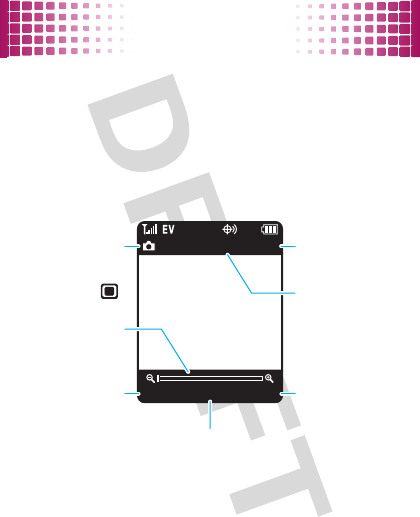
photos
34
photos
see it, capture it, send it!
take & send photos
Find it:
Menu
>
jMultimedia
>
Camera
Shortcut:
From the home screen, press the
camera key
e
.
When you take a photo, your phone shows options to
Send
the photo or
Send to Online Album
. Select a send option, or
press
|
to see other options. You can:
Options PicturesCapture
131 1280x1024
Select camera
options.
Camera Mode
Press
right/left to
zoom in/out.
Press
s
to take a photo.
View photos.
Resolution
Remaining
Shots
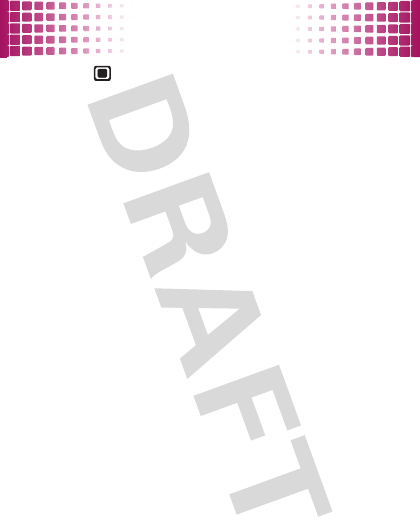
photos
35
•
Press to
save
the photo. The photo is named
after the date and time you took it.
•
Press
Send
to
send
the photo.
•
Press
Options
to
delete
the photo,
save
the photo with
a name you specify, or
set
the photo as a wallpaper or
picture ID.
view photos
Find it:
Menu
>
jMultimedia
>
Pictures
, scroll to a photo
To watch a slideshow, press
Menu
>
jMultimedia
>
Pictures
>
Slideshow
.
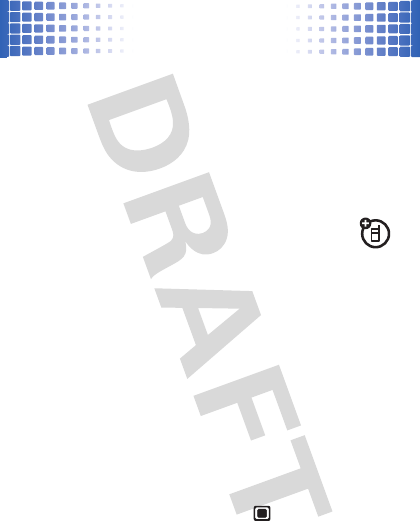
Bluetooth® wireless
36
Bluet ooth® wirel ess
lose the wires and go wireless
turn Bluetooth power on or off
Find it:
Menu
>
uSettings
>
Bluetooth
, press
Turn On
or
Turn Off
Note:
To extend battery life, set Bluetooth power to
Turn Off
when not in use.
connect new devices
To connect with a new device, you need to pair
with it. You only need to do this once for each device—to
connect again, see page 37.
1
Make sure the Bluetooth device you are pairing with
is in discoverable mode (see device instructions).
2
Press
Menu
>
uSettings
>
Bluetooth
>
Add New Device
.
Note:
If Bluetooth power is not turned on, your
phone will ask if you want to
Turn Bluetooth On?
Select
Yes
.
3
Press
OK
to search for available Bluetooth devices.
4
Your phone lists the devices it finds within range.
Scroll to the device and press .
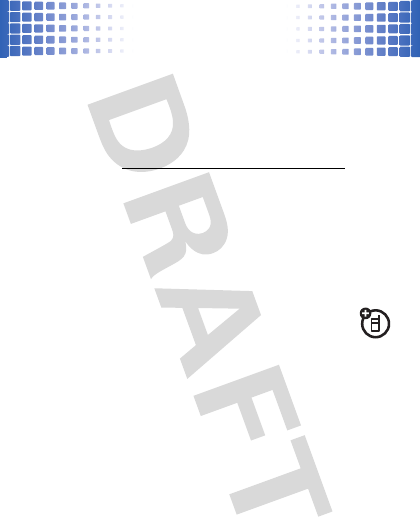
Bluetooth® wireless
37
5
If necessary, enter the device PIN (such as
0000
) and
press
Done
.
Tip:
For specific information about a device, check the
instructions that came with it. For more Bluetooth
support, go to
www.motorola.com/Bluetoothsupport
.
For maximum Bluetooth security
, always connect
Bluetooth devices in a safe, private environment.
Note:
Using a mobile device or accessory while driving
may cause distraction and may be illegal. Always obey
the laws and drive safely.
reconnect devices
To
automatically reconnect
your phone with a
paired device, simply turn the device on when it is near
the phone. If the device doesn’t connect, turn it off and
back on, and make sure your phone’s Bluetooth power
is on.
To
manually reconnect
your phone with a paired device,
press
Menu
>
uSettings
>
Bluetooth
> device name.
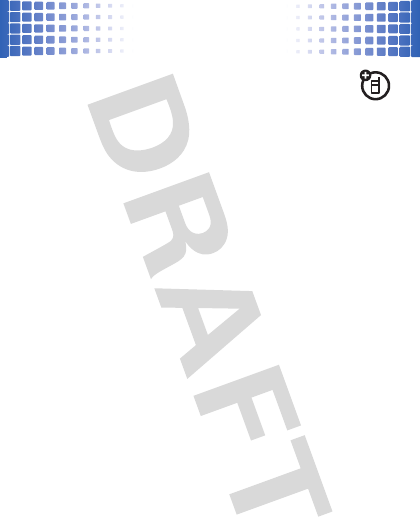
Bluetooth® wireless
38
disconnect devices
To
automatically disconnect
your phone from a
paired device, simply turn the device off.
To
manually disconnect
your phone from a paired
device, press
Menu
>
uSettings
>
Bluetooth
, scroll to the
device and press
Disconnect
.
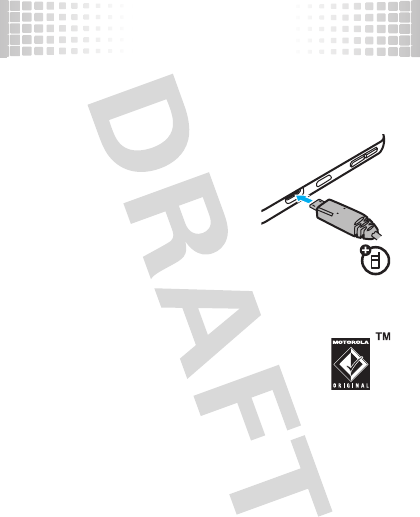
cable connections
39
cable connections
your computer wants a friend
connect
Your phone has a micro USB
connector, so you can connect it
to a PC to transfer data.
Before you connect an optional
USB cable, tell your phone what type of
connection you want to use by pressing
Menu
>
uSettings
>
USB
>
Mass Storage
or
Modem/COM
.
Note:
Motorola Original USB data cables and
supporting software are sold separately.
Check your computer or device to determine
the type of cable you need.
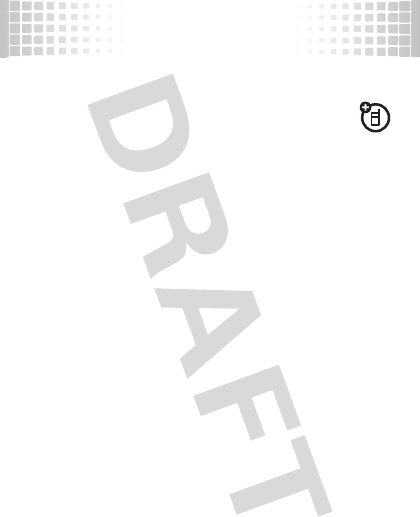
cable connections
40
transfer
Note:
To install an optional microSD memory card
in your phone, see page 7.
Using a USB cable connection, you can connect to your
PC to access your phone’s memory card.
Note:
When your phone is connected to a computer, it
cannot be used for anything else, including making
emergency calls. To restore the phone to normal use,
disconnect it from the computer.
On your phone:
1
Disconnect the cable
from your phone if it’s
connected, then press
Menu
>
uSettings
>
USB
>
Mass Storage
.
2
Connect the cable
to your phone (page 39) and
your PC.
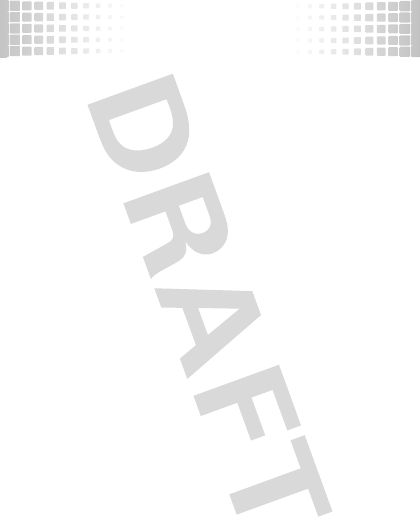
cable connections
41
On your computer:
1
Double-click on “My Computer” to find the
“Removable Disk” icons for your phone and
memory card.
2
Double-click the “Removable Disk” icon for the
memory card.
3
Drag and drop files into these folders on the
memory card (create the folders if necessary):
my_images, my_music, my_sounds, or my_videos.
4
When you’re done, right-click the “Safely Remove
Hardware” icon in the system tray at the bottom of
your computer screen, then select “USB Mass
Storage Device” (your memory card).
5
Disconnect the USB cable.
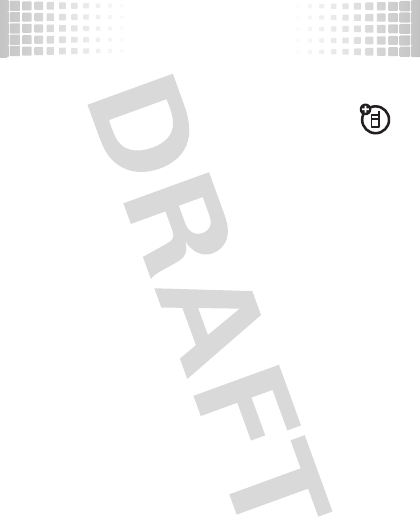
memory card
42
memory card
store more
format
You need to format a memory card (up to 8 GB),
using the phone
, before using it for the first time. This
creates the necessary folders and ensures your phone
can read the contents of the card.
Caution:
Formatting the memory card erases all content
on the card.
Find it:
Menu
>
uSettings
>
Storage Device
>
Memory Card
>
Format Memory Card
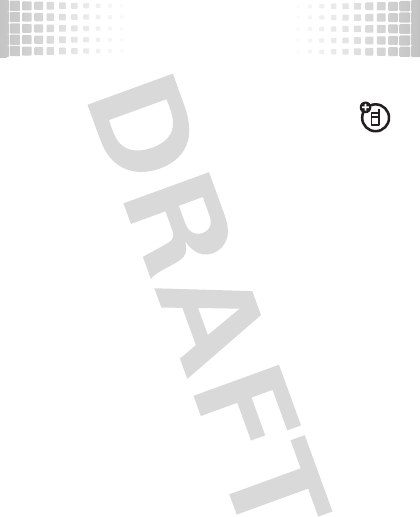
memory card
43
show & manage files
Note:
To install an optional microSD memory card
in your phone, see page 7.
Caution:
Do not remove your memory card while your
phone is using it or writing files on it.
To
see memory card files
, open a file list, such as
jMultimedia
>
Pictures
> memory card folder.
To copy or move a file
from your phone to your
memory card
, scroll to the file and press
Options
>
Manage Files
>
Copy
or
Move
> memory card folder.
To see your card’s
available memory
and other
information, press
Menu
>
uSettings
>
Storage Device
>
Memory Card
>
Memory Card Usage
.
Note:
If you download a copyrighted file and store it on
your memory card, you can use the file only while your
memory card is inserted in your phone. You cannot send,
copy, or change copyrighted files.
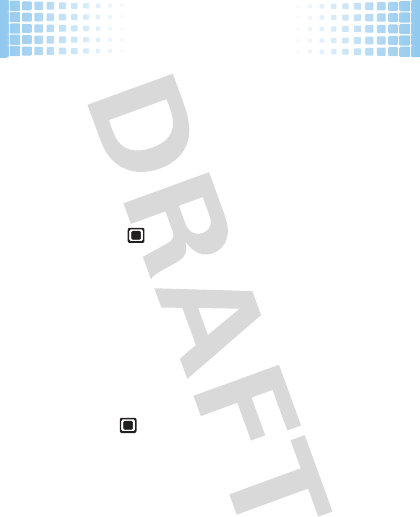
tools
44
tool s
keep up with life
add a calendar event
Find it:
Menu
>
GDatebook
1
Scroll to the desired date and press
Add
.
2
Enter the appointment name and details. To change
the time, recurrence, or alert type, scroll to the line
and press .
3
To save the appointment, press
Save
.
set an alarm
Find it:
Menu
>
mTools
>
Alarm Clock
1
Scroll to
Alarm 1
,
Alarm 2
, or
Alarm 3
, and press
Edit
.
2
Select
On
, and set the alarm time, recurrence, and
alert sound by scrolling to the category and
pressing .
3
When you’re finished, press
Done
.
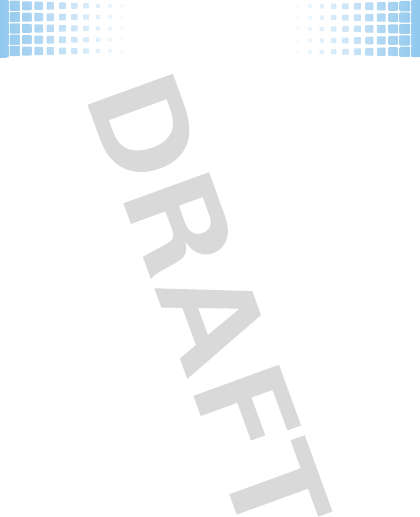
tools
45
calculator
Find it:
Menu
>
mTools
>
Calculators
Select
Basic Calculator
or
Tip Calculator
. Use the keypad to enter
numbers.
For
Basic Calculator
, press
S
to select functions,
*
to
enter a decimal point, and
#
to change to a positive or
negative number.
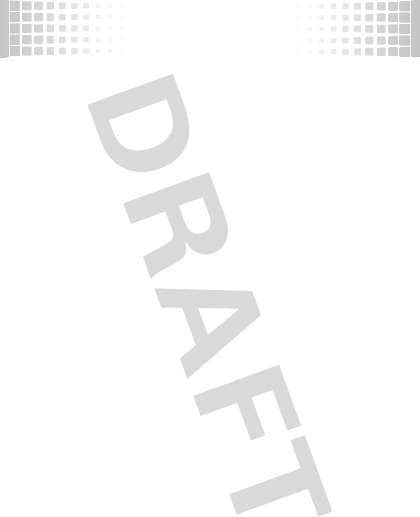
security
46
securi ty
keep your phone safe
codes & passwords
Your phone’s four-digit
lock code
is originally set to the
last four digits of your phone number. To change the lock
code:
Find it:
Menu
>
uSettings
>
Phone
>
Security
1
When prompted, enter the lock code and press
Done
.
2
Select
Edit Lock Code
.
3
Enter the new four-digit lock code in the
Enter New Code
entry area and in the
Confirm New Code
entry area.
4
Press
Done
.
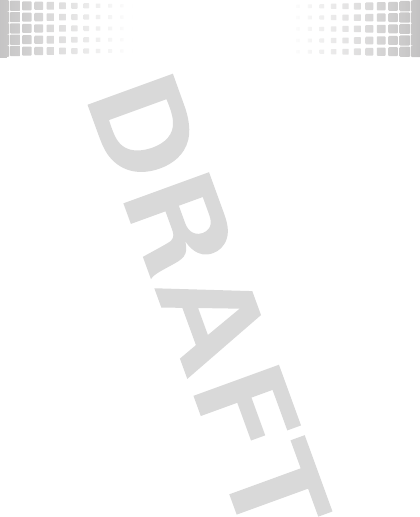
security
47
lock & unlock phone
You can lock your phone to keep others from using it.
Find it:
Menu
>
uSettings
>
Phone
>
Security
1
When prompted, enter the lock code and press
Done
.
2
Select
Lock Phone Now
.
To unlock your phone:
1
From the home screen, press
Unlock
.
2
Enter your lock code and press
Done
.
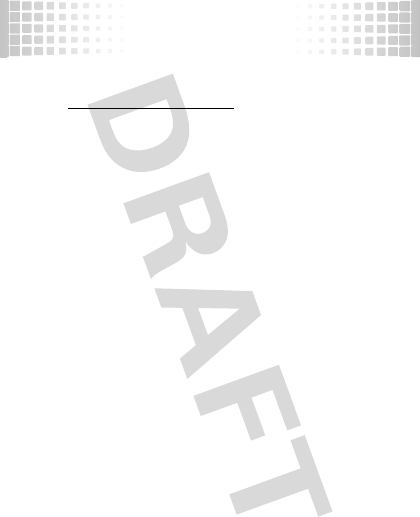
service & repairs
48
service & repairs
we’re here to help
Go to
www.motorola.com/support
, where you can select
from a number of customer care options. You can also
contact the Motorola Customer Support Center at
1-800-331-6456 (United States), 1-888-390-6456
(TTY/TDD United States for hearing impaired), or
1-800-461-4575 (Canada).
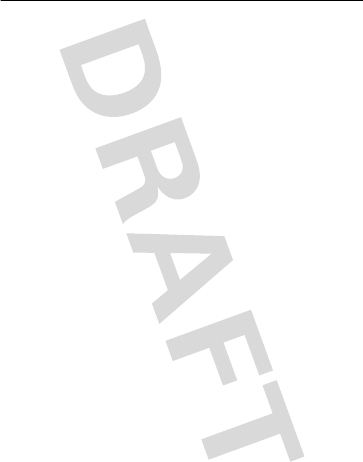
49
Safety, Regulatory & Legal
Battery Use & Safety
Batter y Use & Safety
Important: Handle and store batteries properly to avoid injury or damage.
Most
battery issues arise from improper handling of batteries, and particularly from the
continued use of damaged batteries.
DON’Ts
• Don’t disassemble, crush, puncture, shred, or otherwise attempt to
change the form of your battery.
• Don’t let the phone or battery come in contact with water.
Water can get
into the phone’s circuits, leading to corrosion. If the phone and/or battery get wet,
have them checked by your carrier or contact Motorola, even if they appear to be
working properly.
• Don’t allow the battery to touch metal objects.
If metal objects, such as
jewelry, stay in prolonged contact with the battery contact points, the battery
could become very hot.
• Don’t place your battery near a heat source.
Excessive heat can damage the
phone or the battery. High temperatures can cause the battery to swell, leak, or
malfunction. Therefore:
•
Do
not
dry a wet or damp battery with an appliance or heat source, such as a hair
dryer or microwave oven.
•
Avoid leaving your phone in your car in high temperatures.
DOs
• Do avoid dropping the battery or phone.
Dropping these items, especially on a
hard surface, can potentially cause damage.
• Do contact your service provider or Motorola if your phone or battery has
been damaged from dropping or high temperatures.
Important: Use Motorola Original products for quality assurance and
safeguards.
To aid consumers in identifying authentic Motorola batteries from
non-original or counterfeit batteries (that may not have adequate safety protection),
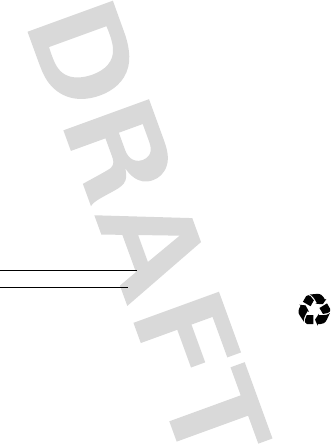
50
Motorola provides holograms on its batteries. Consumers should confirm that any battery
they purchase has a “Motorola Original” hologram.
Motorola recommends you always use Motorola-branded batteries and
chargers.
Motorola mobile devices are designed to work with Motorola batteries. If you
see a message on your display such as
Invalid Battery
or
Unable to Charge
, take the
following steps:
•
Remove the battery and inspect it to confirm that it has a “Motorola Original”
hologram;
•
If there is no hologram, the battery is not a Motorola battery;
•
If there is a hologram, replace the battery and retry charging it;
•
If the message remains, contact a Motorola authorized service center.
Important:
Motorola’s warranty does not cover damage to the phone caused by
non-Motorola batteries and/or chargers.
Warning:
Use of a non-Motorola battery or charger may present a risk of fire, explosion,
leakage, or other hazard.
Proper and safe battery disposal and recycling:
Proper battery disposal is not only
important for safety, it benefits the environment. Consumers may recycle their used
batteries in many retail or service provider locations. Additional information on proper
disposal and recycling may be found on the Web:
• www.motorola.com/recycling
• www.rbrc.org/call2recycle/
(in English only)
Disposal:
Promptly dispose of used batteries in accordance with local
regulations. Contact your local recycling center or national recycling
organizations for more information on how to dispose of batteries.
Warning:
Never dispose of batteries in a fire because they may explode.
Battery Charging
Batter y Charging
Notes for charging your phone’s battery:
•
When charging your battery, keep it near room temperature. Never expose
batteries to temperatures below 0°C (32°F) or above 45°C (113°F) when charging.
•
New batteries are not fully charged.
032375o

51
•
New batteries or batteries stored for a long time may take more time to charge.
•
Motorola batteries and charging systems have circuitry that protects the battery
from damage from overcharging.
Specific Absorption Rate
SAR (IEEE)
Your model wireless phone meets the governmental requirements
for exposure to radio waves.
Your mobile device is a radio transmitter and receiver. It is designed and manufactured to
not exceed limits for exposure to radio frequency (RF) energy set by the Federal
Communications Commission (FCC) of the U.S. Government and by the Canadian
regulatory authorities. These limits are part of comprehensive guidelines and establish
permitted levels of RF energy for the general population. The guidelines are based on
standards that were developed by independent scientific organizations through periodic
and thorough evaluation of scientific studies. The standards include a substantial safety
margin designed for the safety of all persons, regardless of age or health, and to account
for any variations in measurements.
The exposure standard for mobile devices employs a unit of measurement known as the
Specific Absorption Rate (SAR). The IEEE SAR limit set by the FCC and by the Canadian
regulatory authorities is 1.6 watts per kilogram (W/kg), averaged over one gram of tissue.
Tests for SAR are conducted using procedures accepted by the FCC and by Industry
Canada with the mobile device transmitting at its highest certified power level in all
tested frequencies. Although the SAR is determined at the highest certified power level,
the actual SAR level of the mobile device while operating can be below the maximum
value. This is because the mobile device is designed to operate at multiple power levels
so as to use only the power required to reach the network. In general, the closer you are
to a wireless base station, the lower the power output.
Before a mobile device is available for sale to the public in the U.S. and Canada, it must
be tested and certified to the FCC and Industry Canada that it does not exceed the limit
established by each government for safe exposure. The tests are performed in positions
and locations (e.g., at the ear and worn on the body) submitted to the FCC and available
for review by Industry Canada. The highest SAR value for this mobile device when tested
for use at the ear is 1.52 W/kg, and when worn on the body, as described in this guide, is
1.04 W/kg. Body-worn measurements can differ, depending upon available accessories
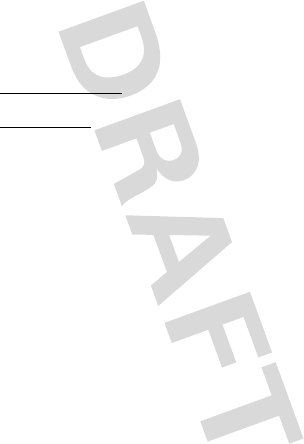
52
and regulatory requirements. The SAR information includes the Motorola testing protocol,
assessment procedure, and measurement uncertainty range for this product.
While there may be differences between the SAR levels of various mobile devices and at
various positions, they meet the governmental requirements for safe exposure. Please
note that improvements to this product model could cause differences in the SAR value
for later products; in all cases, products are designed to be within the guidelines.
Additional information on SAR can be found on the Cellular Telecommunications
& Internet Association (CTIA) Web site:
http://www.phonefacts.net
or the Canadian Wireless Telecommunications Association (CWTA) Web site:
http://www.cwta.ca
Software Copyright Notice
Soft ware Copyright Notice
Motorola products may include copyrighted Motorola and third-party software stored in
semiconductor memories or other media. Laws in the United States and other countries
preserve for Motorola and third-party software providers certain exclusive rights for
copyrighted software, such as the exclusive rights to distribute or reproduce the
copyrighted software. Accordingly, any copyrighted software contained in Motorola
products may not be modified, reverse-engineered, distributed, or reproduced in any
manner to the extent allowed by law. Furthermore, the purchase of Motorola products
shall not be deemed to grant either directly or by implication, estoppel, or otherwise, any
license under the copyrights, patents, or patent applications of Motorola or any
third-party software provider, except for the normal, non-exclusive, royalty-free license to
use that arises by operation of law in the sale of a product.
Content Copyright
Content Copyright
The unauthorized copying of copyrighted materials is contrary to the provisions of the
Copyright Laws of the United States and other countries. This device is intended solely for
copying non-copyrighted materials, materials in which you own the copyright, or materials
which you are authorized or legally permitted to copy. If you are uncertain about your right
to copy any material, please contact your legal advisor.

53
GPS & AGPS
GPS & AGPS
Your mobile device can use Global Positioning System (GPS) signals for location-based
applications. GPS uses satellites controlled by the U.S. government that are subject to
changes implemented in accordance with the Department of Defense policy and the
Federal Radio Navigation Plan. These changes may affect the performance of location
technology on your mobile device.
Your mobile device can also use Assisted Global Positioning System (AGPS), which
obtains information from the cellular network to improve GPS performance. AGPS uses
your wireless service provider's network and therefore airtime, data charges, and/or
additional charges may apply in accordance with your service plan. Contact your wireless
service provider for details.
Your Location
Location-based information includes information that can be used to determine the
approximate location of a mobile device. Mobile phones which are connected to a
wireless network transmit location-based information. Devices enabled with GPS or
AGPS technology also transmit location-based information. Additionally, if you use
applications that require location-based information (e.g. driving directions), such
applications transmit location-based information. This location-based information may be
shared with third parties, including your wireless service provider, applications providers,
Motorola, and other third parties providing services.
Emergency Calls
When you make an emergency call, the cellular network may activate the AGPS
technology in your mobile device to tell the emergency responders your approximate
location.
AGPS has limitations and
might not work in your area
. Therefore:
•
Always tell the emergency responder your location to the best of your ability; and
•
Remain on the phone for as long as the emergency responder instructs you.
Performance Tips
•
Go outside and away from underground locations, covered vehicles, structures
with metal or concrete roofs, tall buildings, and foliage. Indoor performance might

54
improve if you move closer to windows, but some window sun shielding films can
block satellite signals.
•
Move away from radios, entertainment equipment, and other electronic devices.
Safety & General Information
Safety Information
This section contains important information on the safe and efficient operation
of your mobile device. Read this information before using your mobile device.
Exposure to Radio Frequency (RF) Energy
Your mobile device contains a transmitter and receiver. When it is ON, it receives and
transmits RF energy. When you communicate with your mobile device, the system
handling your call controls the power level at which your mobile device transmits.
Your mobile device is designed to comply with local regulatory requirements in your
country concerning exposure of human beings to RF energy.
Operational Precautions
For optimal mobile device performance, and to be sure that human exposure to RF energy
does not exceed the guidelines set forth in the relevant standards, always follow these
instructions and precautions.
Product Operation
When placing or receiving a phone call, hold your mobile device just like you would a
landline phone.
If you wear the mobile device on your body, always place the mobile device in a
Motorola-supplied or approved clip, holder, holster, case, or body harness. If you do not
use a body-worn accessory supplied or approved by Motorola, keep the mobile device and
its antenna at least 2.5 centimeters (1 inch) from your body when transmitting.
Using accessories not supplied or approved by Motorola may cause your mobile device to
exceed RF energy exposure guidelines. For a list of Motorola-supplied or approved
accessories, visit our Web site at:
www.motorola.com
.
RF Energy Interference/Compatibility
Nearly every electronic device is subject to RF energy interference from external sources
if inadequately shielded, designed, or otherwise configured for RF energy compatibility. In
some circumstances, your mobile device may cause interference with other devices.

55
Follow Instructions to Avoid Interference Problems
Turn off your mobile device in any location where posted notices instruct you to do so.
In an aircraft, turn off your mobile device whenever instructed to do so by airline staff. If
your mobile device offers an airplane mode or similar feature, consult airline staff about
using it in flight.
Implantable Medical Devices
If you have an implantable medical device, such as a pacemaker or defibrillator, consult
your physician before using this mobile device.
Persons with implantable medical devices should observe the following precautions:
•
ALWAYS keep the mobile device more than 20 centimeters (8 inches) from the
implantable medical device when the mobile device is turned ON.
•
DO NOT carry the mobile device in the breast pocket.
•
Use the ear opposite the implantable medical device to minimize the potential for
interference.
•
Turn OFF the mobile device immediately if you have any reason to suspect that
interference is taking place.
Read and follow the directions from the manufacturer of your implantable medical device.
If you have any questions about using your mobile device with your implantable medical
device, consult your healthcare provider.
Driving Precautions
The use of wireless phones while driving may cause distraction. Discontinue a call if you
can’t concentrate on driving.
Additionally, the use of wireless devices and their accessories may be prohibited or
restricted in certain areas. Always obey the laws and regulations on the use of these
products.
For more information, see “Smart Practices While Driving.”
Operational Warnings
Obey all posted signs when using mobile devices in public areas.
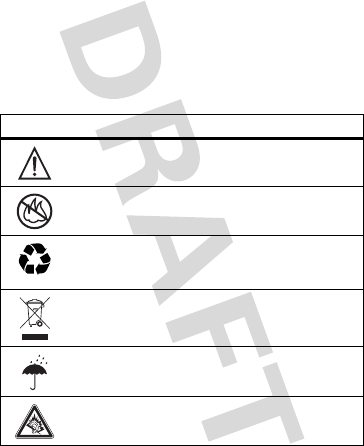
56
Potentially Explosive Atmospheres
Areas with potentially explosive atmospheres are often, but not always, posted and can
include fueling areas, such as below decks on boats, fuel or chemical transfer or storage
facilities, or areas where the air contains chemicals or particles, such as grain dust, or
metal powders.
When you are in such an area, turn off your mobile device, and do not remove, install, or
charge batteries. In such areas, sparks can occur and cause an explosion or fire.
Symbol Key
Your battery, charger, or mobile device may contain symbols, defined as follows:
Symbol Definition
Important safety information follows.
Do not dispose of your battery or mobile device in a fire.
Your battery or mobile device may require recycling in accordance
with local laws. Contact your local regulatory authorities for more
information.
Do not throw your battery or mobile device in the trash.
Do not let your battery, charger, or mobile device get wet.
Listening at full volume to music or voice through a headset may
damage your hearing.
032374o
032376o
032375o
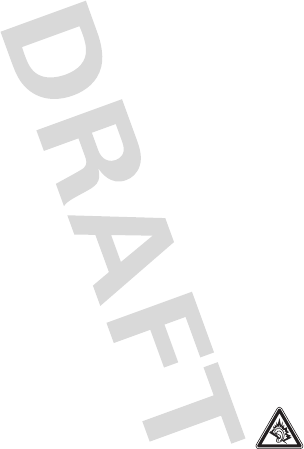
57
Batteries & Chargers
Caution:
Improper treatment or use of batteries may present a danger of fire, explosion,
leakage, or other hazard. For more information, see “Battery Use & Safety.”
Keep Your Mobile Device & Its Accessories Away From
Small Children
These products are not toys and may be hazardous to small children. For example:
•
A choking hazard may exist for small, detachable parts.
•
Improper use could result in loud sounds, possibly causing hearing injury.
•
Improperly handled batteries could overheat and cause a burn.
Glass Parts
Some parts of your mobile device may be made of glass. This glass could break if the
product is dropped on a hard surface or receives a substantial impact. If glass breaks, do
not touch or attempt to remove. Stop using your mobile device until the glass is replaced
by a qualified service center.
Seizures/Blackouts
Some people may be susceptible to epileptic seizures or blackouts when exposed to
flashing lights, such as when playing video games. These may occur even if a person has
never had a previous seizure or blackout.
If you have experienced seizures or blackouts, or if you have a family history of such
occurrences, please consult with your physician before playing video games or enabling a
flashing-lights feature (if available) on your mobile device.
Discontinue use and consult a physician if any of the following symptoms occur:
convulsion, eye or muscle twitching, loss of awareness, involuntary movements, or
disorientation. It is always a good idea to hold the screen away from your eyes, leave the
lights on in the room, take a 15-minute break every hour, and stop use if you are tired.
Caution About High Volume Usage
Warning:
Exposure to loud noise from any source for extended periods of
time may affect your hearing. The louder the volume sound level, the less
time is required before your hearing could be affected. To protect your
hearing:
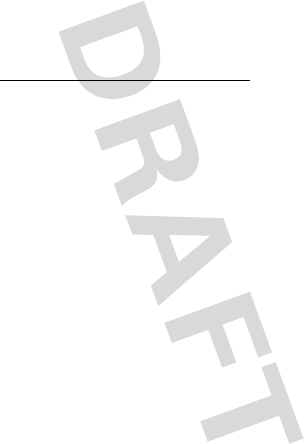
58
•
Limit the amount of time you use headsets or headphones at high volume.
•
Avoid turning up the volume to block out noisy surroundings.
•
Turn the volume down if you can’t hear people speaking near you.
If you experience hearing discomfort, including the sensation of pressure or fullness in
your ears, ringing in your ears, or muffled speech, you should stop listening to the device
through your headset or headphones and have your hearing checked.
For more information about hearing, see our Web site at
direct.motorola.com/hellomoto/nss/AcousticSafety.asp
(in English only).
Repetitive Motion
When you repetitively perform actions such as pressing keys or entering finger-written
characters, you may experience occasional discomfort in your hands, arms, shoulders,
neck, or other parts of your body. If you continue to have discomfort during or after such
use, stop use and see a physician.
[Apr0109]
Industry Canada Notice to Users
Industry Canada Notice
Operation is subject to the following two conditions: (1) This device may not cause
interference and (2) This device must accept any interference, including interference that
may cause undesired operation of the device. See RSS-GEN 7.1.5.
FCC Notice to Users
FCC Notice
The following statement applies to all products that have received FCC
approval. Applicable products bear the FCC logo, and/or an FCC ID in the format
FCC-ID:xxxxxx on the product label.
Motorola has not approved any changes or modifications to this device by the user. Any
changes or modifications could void the user’s authority to operate the equipment. See 47
CFR Sec. 15.21.
This device complies with part 15 of the FCC Rules. Operation is subject to the following
two conditions: (1) This device may not cause harmful interference, and (2) this device
must accept any interference received, including interference that may cause undesired
operation. See 47 CFR Sec. 15.19(3).
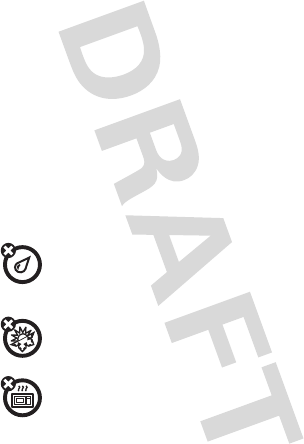
59
This equipment has been tested and found to comply with the limits for a Class B digital
device, pursuant to part 15 of the FCC Rules. These limits are designed to provide
reasonable protection against harmful interference in a residential installation. This
equipment generates, uses and can radiate radio frequency energy and, if not installed
and used in accordance with the instructions, may cause harmful interference to radio
communications. However, there is no guarantee that interference will not occur in a
particular installation. If this equipment does cause harmful interference to radio or
television reception, which can be determined by turning the equipment off and on, the
user is encouraged to try to correct the interference by one or more of the following
measures:
•
Reorient or relocate the receiving antenna.
•
Increase the separation between the equipment and the receiver.
•
Connect the equipment to an outlet on a circuit different from that to which the
receiver is connected.
•
Consult the dealer or an experienced radio/TV technician for help.
Use & Care
Use & Care
To care for your Motorola phone, please keep it away from:
liquids of any kind
Don’t expose your phone to water, rain, extreme humidity, sweat, or other
moisture. If it does get wet, don’t try to accelerate drying with the use of an
oven or dryer, as this may damage the phone.
extreme heat or cold
Avoid temperatures below 0°C/32°F or above 45°C/113°F.
microwaves
Don’t try to dry your phone in a microwave oven.
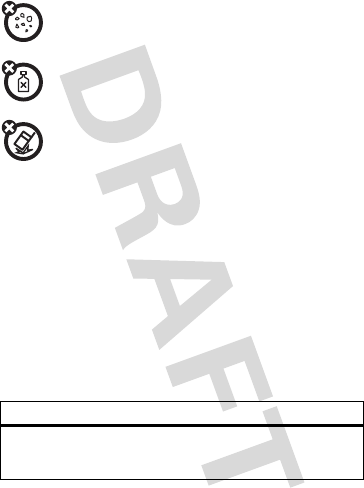
60
dust and dirt
Don’t expose your phone to dust, dirt, sand, food, or other inappropriate
materials.
cleaning solutions
To clean your phone, use only a dry soft cloth. Don’t use alcohol or other
cleaning solutions.
the ground
Don’t drop your phone.
Motorola Limited Warranty for the
United States and Canada
Wa rr a n t y
What Does this Warranty Cover?
Subject to the exclusions contained below, Motorola, Inc. warrants its mobile telephones
(“Products”), Motorola-branded or certified accessories sold for use with these Products
(“Accessories”), and Motorola software contained on CD-ROMs or other tangible media
and sold for use with these Products (“Software”) to be free from defects in materials and
workmanship under normal consumer usage for the period(s) outlined below. This limited
warranty is a consumer's exclusive remedy, and applies as follows to new Motorola
Products, Accessories, and Software purchased by consumers in the United States or
Canada, which are accompanied by this written warranty:
Products and Accessories
Products Covered Length of Coverage
Products and Accessories
as
defined above, unless otherwise
provided for below.
One (1) year
from the date of purchase by the
first consumer purchaser of the product unless
otherwise provided for below.
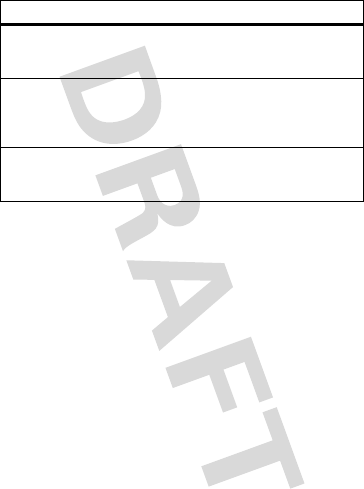
61
Exclusions (Products and Accessories)
Normal Wear and Tear.
Periodic maintenance, repair and replacement of parts due to
normal wear and tear are excluded from coverage.
Batteries.
Only batteries whose fully charged capacity falls below 80% of their rated
capacity and batteries that leak are covered by this limited warranty.
Abuse & Misuse.
Defects or damage that result from: (a) improper operation, storage,
misuse or abuse, accident or neglect, such as physical damage (cracks, scratches, etc.) to
the surface of the product resulting from misuse; (b) contact with liquid, water, rain,
extreme humidity or heavy perspiration, sand, dirt or the like, extreme heat, or food;
(c) use of the Products or Accessories for commercial purposes or subjecting the Product
or Accessory to abnormal usage or conditions; or (d) other acts which are not the fault of
Motorola, are excluded from coverage.
Use of Non-Motorola Products and Accessories.
Defects or damage that result from
the use of non-Motorola branded or certified Products, Accessories, Software or other
peripheral equipment are excluded from coverage.
Unauthorized Service or Modification.
Defects or damages resulting from service,
testing, adjustment, installation, maintenance, alteration, or modification in any way by
someone other than Motorola, or its authorized service centers, are excluded from
coverage.
Decorative Accessories and
Cases.
Decorative covers, bezels,
PhoneWrap™ covers and cases.
Limited lifetime warranty
for the lifetime of
ownership by the first consumer purchaser of
the product.
Monaural Headsets.
Ear buds
and boom headsets that transmit
mono sound through a wired
connection.
Limited lifetime warranty
for the lifetime of
ownership by the first consumer purchaser of
the product.
Products and Accessories that
are Repaired or Replaced.
The balance of the original warranty or
for ninety (90) days
from the date returned to
the consumer, whichever is longer.
Products Covered Length of Coverage
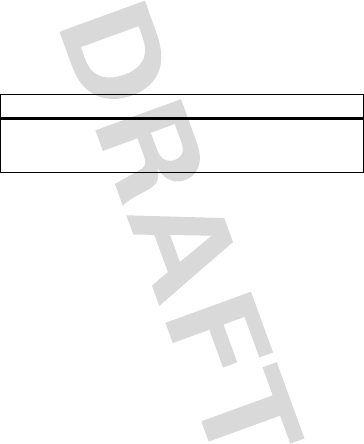
62
Altered Products.
Products or Accessories with (a) serial numbers or date tags that have
been removed, altered or obliterated; (b) broken seals or that show evidence of
tampering; (c) mismatched board serial numbers; or (d) nonconforming or non-Motorola
housings, or parts, are excluded from coverage.
Communication Services.
Defects, damages, or the failure of Products, Accessories or
Software due to any communication service or signal you may subscribe to or use with
the Products Accessories or Software is excluded from coverage.
Software
Exclusions (Software)
Software Embodied in Physical Media.
No warranty is made that the software will
meet your requirements or will work in combination with any hardware or software
applications provided by third parties, that the operation of the software products will be
uninterrupted or error free, or that all defects in the software products will be corrected.
Software NOT Embodied in Physical Media.
Software that is not embodied in
physical media (e.g. software that is downloaded from the Internet), is provided “as is”
and without warranty.
Who is Covered?
This warranty extends only to the first consumer purchaser, and is not transferable.
What Will Motorola Do?
Motorola, at its option, will at no charge repair, replace or refund the purchase price of
any Products, Accessories or Software that does not conform to this warranty. We may
use functionally equivalent reconditioned/refurbished/pre-owned or new Products,
Accessories or parts. No data, software or applications added to your Product, Accessory
or Software, including but not limited to personal contacts, games and ringer tones, will
Products Covered Length of Coverage
Software.
Applies only to physical defects in the
media that embodies the copy of the software (e.g.
CD-ROM, or floppy disk).
Ninety (90) days
from the
date of purchase.
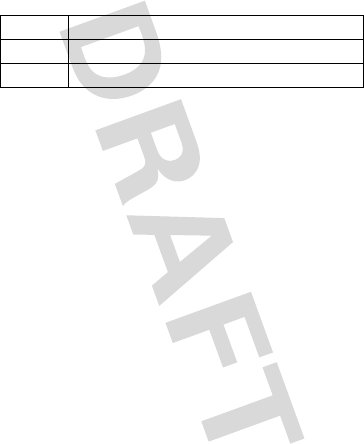
63
be reinstalled. To avoid losing such data, software, and applications, please create a back
up prior to requesting service.
How to Obtain Warranty Service or Other Information
You will receive instructions on how to ship the Products, Accessories or Software, at
your expense, to a Motorola Authorized Repair Center. To obtain service, you must
include: (a) a copy of your receipt, bill of sale or other comparable proof of purchase; (b) a
written description of the problem; (c) the name of your service provider, if applicable;
(d) the name and location of the installation facility (if applicable) and, most importantly;
(e) your address and telephone number.
What Other Limitations are There?
ANY IMPLIED WARRANTIES, INCLUDING WITHOUT LIMITATION THE IMPLIED
WARRANTIES OF MERCHANTABILITY AND FITNESS FOR A PARTICULAR PURPOSE,
SHALL BE LIMITED TO THE DURATION OF THIS LIMITED WARRANTY, OTHERWISE THE
REPAIR, REPLACEMENT, OR REFUND AS PROVIDED UNDER THIS EXPRESS LIMITED
WARRANTY IS THE EXCLUSIVE REMEDY OF THE CONSUMER, AND IS PROVIDED IN LIEU
OF ALL OTHER WARRANTIES, EXPRESS OR IMPLIED. IN NO EVENT SHALL MOTOROLA BE
LIABLE, WHETHER IN CONTRACT OR TORT (INCLUDING NEGLIGENCE) FOR DAMAGES IN
EXCESS OF THE PURCHASE PRICE OF THE PRODUCT, ACCESSORY OR SOFTWARE, OR
FOR ANY INDIRECT, INCIDENTAL, SPECIAL OR CONSEQUENTIAL DAMAGES OF ANY
KIND, OR LOSS OF REVENUE OR PROFITS, LOSS OF BUSINESS, LOSS OF INFORMATION
OR DATA, SOFTWARE OR APPLICATIONS OR OTHER FINANCIAL LOSS ARISING OUT OF
OR IN CONNECTION WITH THE ABILITY OR INABILITY TO USE THE PRODUCTS,
ACCESSORIES OR SOFTWARE TO THE FULL EXTENT THESE DAMAGES MAY BE
DISCLAIMED BY LAW.
Some states and jurisdictions do not allow the limitation or exclusion of
incidental or consequential damages, or limitation on the length of an implied
USA All Products, Accessories, and Software:
1-800-331-6456
Canada All Products:
1-800-461-4575
TTY
1-888-390-6456

64
warranty, so the above limitations or exclusions may not apply to you. This
warranty gives you specific legal rights, and you may also have other rights that
vary from state to state or from one jurisdiction to another.
Hearing Aid Compatibility with
Mobile Phones
Heari ng Aids
Some Motorola phones are measured for compatibility with hearing aids. If the box for
your particular model has “Rated for Hearing Aids” printed on it, the following
explanation applies.
When some mobile phones are used near some hearing devices (hearing aids and
cochlear implants), users may detect a buzzing, humming, or whining noise. Some hearing
devices are more immune than others to this interference noise, and phones also vary in
the amount of interference they generate.
The wireless telephone industry has developed ratings for some of their mobile phones, to
assist hearing device users in finding phones that may be compatible with their hearing
devices. Not all phones have been rated. Phones that are rated have the rating on their
box or a label on the box. To maintain the published Hearing Aid Compatibility (HAC)
rating for this mobile phone, use only the original equipment battery model.
The ratings are not guarantees. Results will vary depending on the user’s hearing device
and hearing loss. If your hearing device happens to be vulnerable to interference, you may
not be able to use a rated phone successfully. Trying out the phone with your hearing
device is the best way to evaluate it for your personal needs.
M-Ratings:
Phones rated M3 or M4 meet FCC requirements and are likely to generate
less interference to hearing devices than phones that are not labeled. M4 is the
better/higher of the two ratings.
T-Ratings:
Phones rated T3 or T4 meet FCC requirements and are likely to be more usable
with a hearing device’s telecoil (“T Switch” or “Telephone Switch”) than unrated phones.
T4 is the better/higher of the two ratings. (Note that not all hearing devices have telecoils
in them.)
Hearing devices may also be measured for immunity to this type of interference. Your
hearing device manufacturer or hearing health professional may help you find results for
your hearing device. The more immune your hearing aid is, the less likely you are to
experience interference noise from mobile phones.
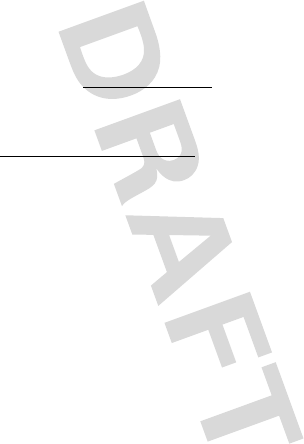
65
Information from the World Health
Organization
WHO Information
Present scientific information does not indicate the need for any special precautions for
the use of mobile phones. If you are concerned, you may want to limit your own or your
children’s RF exposure by limiting the length of calls or by using handsfree devices to keep
mobile phones away from your head and body.
Source: WHO Fact Sheet 193
Further information:
http://www.who.int/peh-emf
Product Registration
Registration
Online Product Registration:
www.motorola.com/us/productregistration
Product registration is an important step toward enjoying your new Motorola product.
Registering permits us to contact you for product or software updates and allows you to
subscribe to updates on new products or special promotions. Registration is not required
for warranty coverage.
Please retain your original dated sales receipt for your records. For warranty service of
your Motorola Personal Communications Product you will need to provide a copy of your
dated sales receipt to confirm warranty status.
Thank you for choosing a Motorola product.
Export Law Assurances
Export Law
This product is controlled under the export regulations of the United States of America
and Canada. The Governments of the United States of America and Canada may restrict
the exportation or re-exportation of this product to certain destinations. For further
information contact the U.S. Department of Commerce or the Canadian Department of
Foreign Affairs and International Trade.
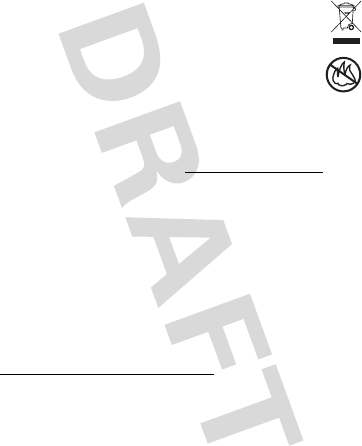
66
Caring for the Environment by
Recycling
Recycli ng Inform ation
This symbol on a Motorola product means the product should not be disposed
of with household waste.
Disposal of your Mobile Device & Accessories
Please do not dispose of mobile devices or electrical accessories (such as
chargers, headsets, or batteries) with your household waste. Do not dispose
of your battery or mobile device in a fire. These items should be disposed of
in accordance with the national collection and recycling schemes operated by
your local or regional authority. Alternatively, you may return unwanted mobile devices
and electrical accessories to any Motorola Approved Service Center in your region.
Details of Motorola approved national recycling schemes, and further information on
Motorola recycling activities can be found at:
www.motorola.com/recycling
Disposal of your Mobile Device Packaging &
Product Guide
Product packaging and product guides should only be disposed of in accordance with
national collection and recycling requirements. Please contact your regional authorities
for more details.
California Perchlorate Label
Perchlorat e Label
Some mobile phones use an internal, permanent backup battery on the printed circuit
board that may contain very small amounts of perchlorate. In such cases, California law
requires the following label:
Perchlorate Material – special handling may apply. See
www.dtsc.ca.gov/hazardouswaste/perchlorate
There is no special handling required by consumers.
032376o
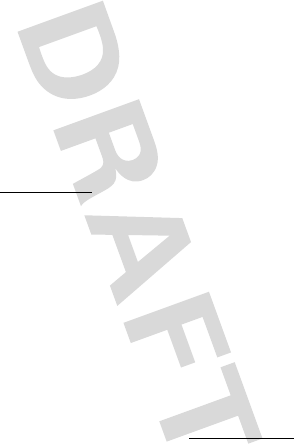
67
Privacy & Data Security
Privac y & Data Secur ity
Motorola understands that privacy and data security are important to everyone. Because
some features of your mobile device may affect your privacy or data security, please
follow these recommendations to enhance protection of your information:
• Monitor access
—Keep your mobile device with you and do not leave it where
others may have unmonitored access. Lock your device’s keypad where this
feature is available.
• Keep software up to date
—If Motorola or a software/application vendor
releases a patch or software fix for your mobile device that updates the device’s
security, install it as soon as possible.
• Erase before recycling
—Delete personal information or data from your mobile
device prior to disposing of it or turning it in for recycling. For instructions on how
to delete all personal information from your device, see your product guide.
Note:
For information on backing up your mobile device data before erasing it, go
to
www.motorola.com
and navigate to the “downloads” section of the
consumer Web page for “Motorola Backup” or “Motorola Phone Tools.”
• Location-based information
—Location-based information includes
information that can be used to determine the approximate location of a mobile
device. Mobile phones which are connected to a wireless network transmit
location-based information. Devices enabled with GPS or AGPS technology also
transmit location-based information. Additionally, if you use applications that
require location-based information (e.g. driving directions), such applications
transmit location-based information. This location-based information may be
shared with third parties, including your wireless service provider, applications
providers, Motorola, and other third parties providing services.
• Other information your device may transmit
—Your device may also transmit
testing and other diagnostic (including location-based) information, and other
non-personal information to Motorola or other third-party servers. This
information is used to help improve products and services offered by Motorola.
If you have further questions regarding how the use of your mobile device may impact
your privacy or data security, please contact Motorola at
privacy@motorola.com
, or
contact your service provider.
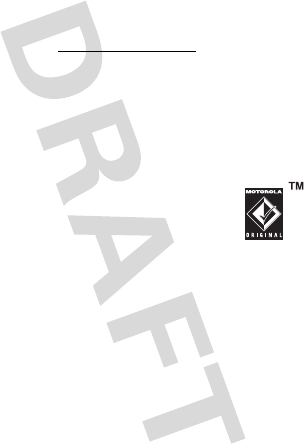
68
Smart Practices While Driving
Drivi ng Safety
Drive Safe, Call Smart
Check the laws and regulations on the use of mobile devices and their
accessories in the areas where you drive. Always obey them. The use of these
devices may be prohibited or restricted in certain areas—for example,
handsfree use only. Go to www.motorola.com/callsmart (in English only) for
more information.
Your mobile device lets you communicate by voice and data—almost anywhere, anytime,
wherever wireless service is available and safe conditions allow. When driving a car,
driving is your first responsibility. If you choose to use your mobile device while driving,
remember the following tips:
• Get to know your Motorola mobile device and its features such as speed
dial and redial.
If available, these features help you to place your call without
taking your attention off the road.
• When available, use a handsfree device.
If possible, add
an additional layer of convenience to your mobile device with
one of the many Motorola Original handsfree accessories
available today.
• Position your mobile device within easy reach.
Be able to
access your mobile device without removing your eyes from the road. If you
receive an incoming call at an inconvenient time, if possible, let your voicemail
answer it for you.
• Let the person you are speaking with know you are driving; if necessary,
suspend the call in heavy traffic or hazardous weather conditions.
Rain,
sleet, snow, ice, and even heavy traffic can be hazardous.
• Do not take notes or look up phone numbers while driving.
Jotting down a
“to do” list or going through your address book takes attention away from your
primary responsibility—driving safely.
• Dial sensibly and assess the traffic; if possible, place calls when your
car is not moving or before pulling into traffic.
If you must make a call while
moving, dial only a few numbers, check the road and your mirrors, then continue.

69
• Do not engage in stressful or emotional conversations that may be
distracting.
Make people you are talking with aware you are driving and suspend
conversations that can divert your attention away from the road.
• Use your mobile device to call for help.
Dial 911 or other local emergency
number in the case of fire, traffic accident, or medical emergencies (wherever
wireless phone service is available).
• Use your mobile device to help others in emergencies.
If you see an auto
accident, crime in progress, or other serious emergency where lives are in danger,
call 911 or other local emergency number (wherever wireless phone service is
available), as you would want others to do for you.
• Call roadside assistance or a special non-emergency wireless
assistance number when necessary.
If you see a broken-down vehicle posing
no serious hazard, a broken traffic signal, a minor traffic accident where no one
appears injured, or a vehicle you know to be stolen, call roadside assistance or
other special non-emergency wireless number (wherever wireless phone service
is available).
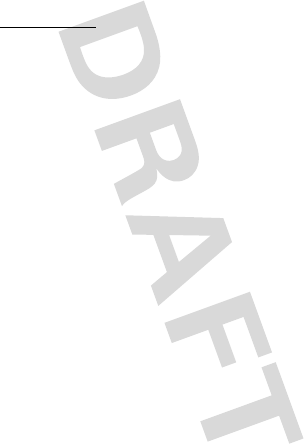
70
Motorola, Inc.
Consumer Advocacy Office
600 N US Hwy 45
Libertyville, IL 60048
www.hellomoto.com
Note:
Do not ship your phone to the above address. If you need to return your phone for
repairs, replacement, or warranty service, please contact the Motorola Customer Support
Center at:
1-800-331-6456 (United States)
1-888-390-6456 (TTY/TDD United States for hearing impaired)
1-800-461-4575 (Canada)
Certain mobile phone features are dependent on the capabilities and settings of your
service provider’s network. Additionally, certain features may not be activated by your
service provider, and/or the provider’s network settings may limit the feature’s
functionality. Always contact your service provider about feature availability and
functionality. All features, functionality, and other product specifications, as well as the
information contained in this guide, are based upon the latest available information and
believed to be accurate at the time of printing. Motorola reserves the right to change or
modify any information or specifications without notice or obligation.
MOTOROLA and the Stylized M Logo are registered in the US Patent & Trademark Office.
The Bluetooth trademarks are owned by their proprietor and used by Motorola, Inc. under
license. Microsoft, Windows, Windows Me, and Windows Vista are registered
trademarks of Microsoft Corporation in the United States and other countries. All other
product or service names are the property of their respective owners.
© 2009 Motorola, Inc. All rights reserved.
Caution:
Changes or modifications made in the radio phone, not expressly approved by
Motorola, will void the user’s authority to operate the equipment.
Manual Number: TBD-A
U.S. patent Re. 34,976
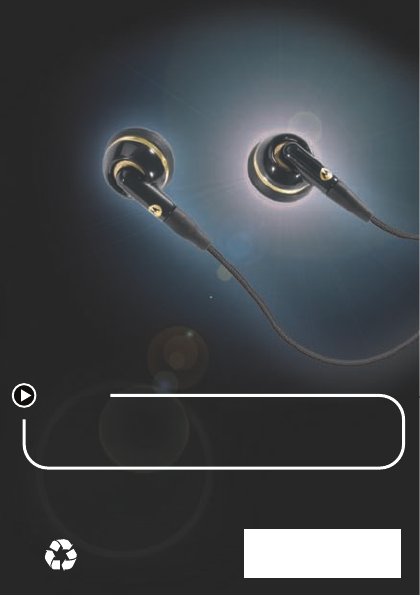
more information
accessories
GO TO
accessories: www.motorola.com
guides: www.motorola.com/support